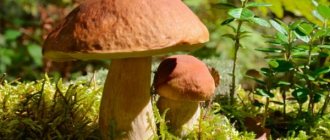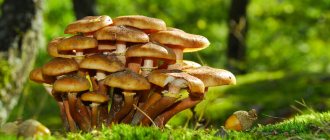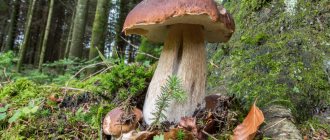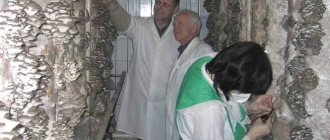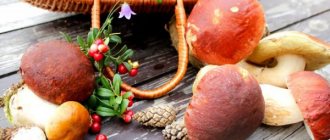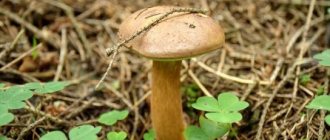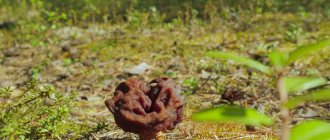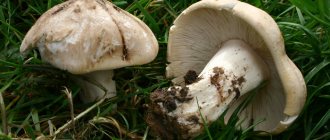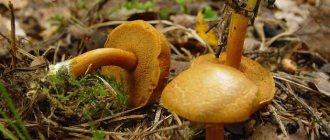Mushrooms
0
2469
Article rating
Kira Stoletova
The Oryol region is one of the regions of Russia richest in edible mushrooms. The abundance of forests combined with a temperate continental climate made this area a playground for “silent hunting.” Everyone in the Oryol region loves mushrooms and enriches their diet with them.
Mushroom picking in the Oryol region
Mushrooms area
Most of the species growing in the Oryol region are edible. There are 44 species recorded in the region. Of these, 23 are rare and 4 are included in the Red Book. Along with them, inedible and poisonous species can be found in local forests and undergrowth. Mushrooms are collected in this region almost all year round.
Coat of arms and flag of the Oryol region
Morels open the season in March-April. They grow in deciduous or mixed forests solitarily and in clusters. In October, winter mushrooms appear, which, in the absence of severe frosts, can grow until March. Their rapid growth begins after the temperature drops to 10 degrees. The second name for winter mushrooms is flammulins
In severe frosts, they fall into a state of suspended animation, but do not die. At the first thaw, their growth resumes. You can find flammulins in the vicinity of the village of Naryshkino, located 25 km from Orel in the direction of Moscow and the Oryol Polesie National Park.
The latter is famous for its harvests of royal mushrooms and is open to the public. Its territory of 85 hectares is located in the northwestern part of the region and covers the Khotynetsky and Znamensky districts. Many residents of Oryol and neighboring regions come here specifically to pick mushrooms for several days, combining this activity with relaxation at a local camp site.
Expert opinion
Gennady Sergeevich Rylov
A great expert in mycology and an avid mushroom picker. Knows everything about mushrooms, their types and places of growth
The peak of mass harvesting in the Oryol region occurs in September. Maturation occurs unevenly across species. Different areas of the region have their own edible mushrooms. Each of them chooses the optimal soil and climatic conditions for their growth.
Shablynsky and Dmitrovsky districts
Despite the fact that in recent years mixed forests with deciduous and coniferous trees growing in their area have become very popular, allowing them to collect more prey, two areas located within the Oryol region do not lose their relevance. The Dmitrovsky and Shablynsky districts with a deciduous zone have repeatedly delighted us with noble mushrooms during the harvest season and consoled us with conditionally edible species in the off-season.
If you know the distinctive characteristics that separate an edible mushroom from a false or poisonous one, even a novice mushroom picker will not leave the forest with an empty basket in 2022. The most important thing is not to forget about weather conditions. It is recommended to focus on the beginning of fruiting by heavy rainfall. For example, from the beginning of the rains it is worth waiting 5-7 days so that the mycelium has time to wake up and the mushrooms have time to grow, becoming suitable for collection.
Edible
Edible mushrooms include species that do not contain poisons that can cause poisoning. They do not need to be subjected to special processing. The cut of such mushrooms quickly turns black or blue. The most common types:
- boletus or porcini mushrooms (grow in clusters in mixed and deciduous forests);
- oyster mushrooms (grow on trees);
- milk mushrooms (large groups should be looked for on moist soils in birch and mixed forests);
- chanterelles (grow everywhere, prefer pine areas);
- boletus (they love small spruce and pine trees);
- boletus and boletus (can grow next to any trees);
- saffron milk caps (grow in groups on calcareous and acidic soils in ravines, spruce forests and pine forests);
- honey mushrooms (grow on stumps and dried trees).
Edible mushrooms are collected in the Oryol region for salting, pickling, drying, freezing, boiling and frying. Each type has its own set of useful properties.
Photo gallery of listed mushrooms
tineoenvertical_linares
maapippu
Safety measures in the forest
Naturally, to travel to an unfamiliar place, you need to be properly prepared so that a fun pastime does not turn into a long search for a lost mushroom picker. It’s best to go on a “silent hunt” with a friendly group - it’s more fun, it’s difficult to get lost, and help will come faster if you shout louder.
As soon as you realize you are lost, stop immediately. Don't take a single step without thinking. Stay focused and don't panic. Think only about how to get to the place where the familiar path begins. To do this: first, remember the last sign on your path and try to get to it. Secondly, remember familiar landmarks: highway, railroad, river, buildings, etc.
Third, listen. Perhaps, among the bird noise there are other sounds: a tractor is working, a dog is barking, a train is traveling, etc. If you haven't found any landmarks, try to climb the tallest tree (first, evaluate your strength). From a height there is a high probability of seeing various pipes, antennas, and power transmission towers.
Inedible mushrooms
This group includes mushrooms that are unsuitable for food due to excessive hardness, unpleasant odor and taste. They contain mild toxic substances that can be removed with special treatment. To do this, they are boiled or dried several times. The most common mushrooms from this group in the region are:
- death cap;
- false raincoat;
- toadstools.
bo_diesel78
micofilos.chile
doody_mary
Mushroom places 2022 Tver and the map in the photo
Based on reviews from local residents who have been mushroom picking at least several times this year, we can conclude that edible mushrooms are actively sprouting in 5 places in the Tver region. The map of mushroom places includes:
- Bezhetsk highway, namely 18 km. There, mushroom pickers find mushrooms, autumn mushrooms and black milk mushrooms.
- A large number of boletus is observed in the villages of Kumordino and Mednoye. There, mushroom pickers pick “snotty” mushrooms, ideal for preparing for the winter, freezing, frying and baking with potatoes.
- In the Tver region in Konakovo, near the airport, where there is a clean forest, you can find a lot of porcini and Polish mushrooms, moss mushrooms and honey mushrooms.
- On the territories of several highways, close to the coast of the Volga River, you can find obabka, saffron milk caps, boletus and rowers.
- The least number of mushrooms, compared to the previous four places, was located near the Yunost residential area. There they collect only obabka, bluelegs and rows.
Poisonous
The most dangerous group of fungi that can cause: food poisoning, disruption of the nervous system and death. The most common representatives of this group in the region are:
- fly agaric (causes suffocation, fainting, stomach upset, death);
- toadstool (acute poisoning);
- lines (similar to morels, especially dangerous for children).
mushroom fixation
coastalnoise
Universal tips for mushroom pickers
For thousands of years, people have enjoyed this tasty and nutritious product. And the masters of mushroom hunting have developed a special science of how to properly collect forest gifts. So, one of the rules: they need to be placed with their caps down. Those mushrooms whose legs are long and fragile are placed on their side.
During the excessively wet season, look for mushroom spots in sunny valleys and hills. When summer is dry, mushrooms hide in the depths, under the branches.
They are collected before sunrise. There are two reasons for this. The first is that there are fewer competitors, which means more choice. The second is that in gray light it is easier to see the hats. The oblique rays of the luminary blind the eyes.
The mushroom should be cut as close to the ground as possible - this way the stem will not rot and damage the overall system. The “kids” should be left behind. In a few days they will grow up, and if not you, then they will bring joy to another person.
Fans of “quiet hunting” will definitely love the local mushroom places - Gatchina can be deservedly proud of them.
Mass mushroom harvest calendar
Table
| Name. | April. | May. | June. | July. | August. | September. | October-March. |
| Boletuses. | – | – | V | V | V | V | V |
| Oyster mushrooms. | – | V | V | V | V | V | – |
| Autumn oyster mushrooms. | – | – | – | – | – | V | – |
| Oyster mushrooms are pink. | – | – | – | – | V | V | – |
| The milk mushrooms are real. | – | – | – | – | V | V | – |
| Milk mushrooms are black. | – | – | – | V | V | V | – |
| Chanterelles. | – | – | – | V | V | V | – |
| Butter. | – | – | – | V | V | V | – |
| Honey mushrooms. | – | – | V | V | V | V | – |
| Boletus mushrooms. | – | – | V | V | V | V | – |
| Boletuses. | – | – | V | V | V | V | – |
| Saffron milk caps. | – | – | – | – | V | V | – |
| Champignon. | – | – | V | V | V | V | – |
| Flammulins. | – | – | – | – | – | – | V |
Morel cap
A small mushroom similar to morels, but it is not a real morel, but belongs to the genus “Verpa”. By the way, the Latin name of the cap is translated into Russian as “Bohemian verpa.”
With such a “noble” name, this mushroom should definitely be edible! In principle, this is true: the morel cap can be consumed in the same way as morels - after boiling without decoction.
This fungus grows in light but damp forests - on loamy and sandy loam soils. Loves lowlands, floodplains of streams, slightly swampy areas, simply put - all those places where it is humid. Mycorrhiza forms with trees such as aspen, linden, and birch; where they are not present, the fungus does not grow. Fruits in the second half of April - first half of May. Its fruiting bodies are very small in size - the diameter of the cap usually does not exceed 3 centimeters.
Summarizing
We are adopting the route Orel – Paslovo – Kleymenovo An excellent option for a weekend walk. 40 km one way (maximum, an hour of quiet driving), if you leave in the morning, you’ll be home by lunchtime. The road is wonderful.
What to see and do. Holy spring in the village of Paslovo. Walk through mushroom places. The estate of Afanasy Fet in Kleymenovo (more precisely, not an estate, but a church with a crypt). On the way you can stop by the base in Pronino.
Cost of travel? 300 rubles for gasoline. Tea in a thermos and something to snack on. Go!
Features of chanterelles
The chanterelle's hat is yellow or orange in color, up to 10 cm in diameter, slightly depressed, and its edge area is wavy. The surface is velvety, smooth and dry. The leg is also small in size - up to 8 cm, slightly lighter in color than the cap. .
The pulp has a good mushroom aroma, it can be white or white-yellow. The peculiarity of the pulp is that its smell is not entirely mushroom, it is more like the aroma of dried fruits or field herbs.
Did you know? There is an opinion that chanterelles are not wormy. Professional mushroom pickers claim that their body is indeed much less affected by insects and pests than other species.
The saffron milk cap is real
Photo 4. Here it is - a real saffron milk cap, the standard of taste among other saffron milk caps. Photo credit: Electrostatico.
It is also common saffron milk cap, pine saffron milk cap. It also has other names - autumn, pine forest, delicacy, noble. It is clear that the mushroom received some of these epithets for its excellent taste. And indeed, many mushroom pickers are inclined to believe that pine saffron milk cap is the best among its fellows. The author of these lines is of the same opinion. In my opinion, properly washed, salted and aged pine saffron milk caps are just a great snack. If you chop them with onions and season with vegetable oil or sour cream, you will get a wonderful salad that goes very harmoniously with crumbly boiled potatoes.
Popular articles Roses - planting and care in open ground for beginners
The common camelina is quite widely distributed, found in both the European and Asian parts of the continent. Very recognizable due to its bright orange cap.
This fungus, of course, forms mycorrhiza with pine. Therefore, you need to look for it where this tree grows. However, the presence of pine trees in the forest is not the main condition. The pine saffron milk cap loves warmth, so it is most often found at the edges of clearings, in clearings, clearings, along the sides of forest roads - where the sun warms the ground well. But it grows especially en masse in young pine forests, where the trees are about 4-5 meters high. Loves mossy or grassy places.
Photo 5. A young pine forest is a place where saffron milk caps grow densely and gather in large quantities.
In such forests, saffron milk caps grow together, and sometimes so densely that you can collect at least a medium-sized bucket of them from one square meter.
I remember once I was collecting saffron milk caps in a similar pine forest that grew up on the site of an abandoned village in the distant Bashkir wilderness. The forest was about 10 years old - the height of the trees did not exceed 4 meters. The pine trees grew quite densely and at their feet there were thick layers of sphagnum moss. And on top there was a real mushroom “Klondike” - a real carpet of saffron milk caps, which here and there stood in dense, numerous herds. I remember how I greedily pounced on mushrooms, how I cut hundreds of them, filling baskets, bags, a jacket, a sweater - everything I could carry. And this despite the fact that I chose only more or less young mushrooms, because there were twice as many old, overgrown burdocks growing there. On top of everything else, a good third of the mushrooms turned out to be wormy - they had to be thrown away. Somehow I overcame my own greed and stopped in time - otherwise I would hardly have been able to steal the collected mushrooms from the forest. But I’m sure - if I had a team and more containers then - I could have taken a hundred buckets from that fishing line. By the way, a river flowed not far from it - I immediately suspected that this could be one of the positive factors that ensured such a breathtaking yield for saffron milk caps in that place. Subsequent observations in other forests only confirmed this.
The period of fruiting of the true saffron milk cap is very extended. Its fruiting bodies are found both at the beginning of June - along with the first boletus, and at the end of October - before the first stable snow cover. However, its most massive “waves” are observed in mid-summer and early autumn.
